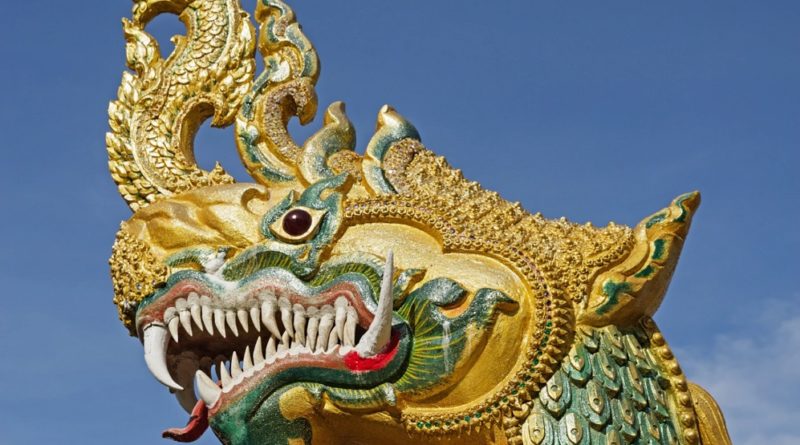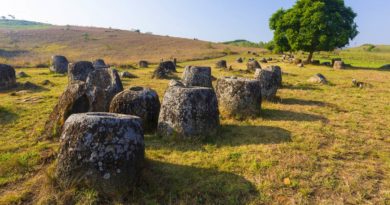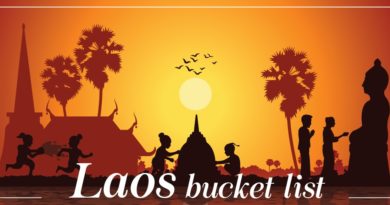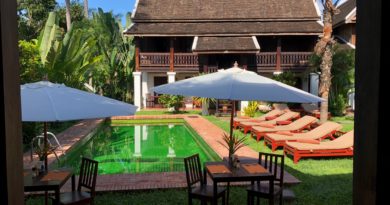Why Laos Thinks This Serpent God Deserves UNESCO Status
Source: National Geographic
In Laos, a legend holds that a handsome half-serpent, half-human water spirit known as a naga lures a beautiful weaver to be his bride in the depths of the Mekong River. Although you’ll see this dragon-like god everywhere in southeast Asia—grinning from rooflines, twisting across temple murals, and forming the stair railings that lead into prayer halls—the naga is a particularly essential motif in Laotian textiles.
Kiang Ounphaivong, a weaver at Ock Pop Tok, an artisan studio in Louangphabang, Laos, incorporates naga elements into every textile, just as her mother and grandmother did before her. “Maybe if I weave something really beautiful, the naga will marry me, too,” she laughs.
The naga is so significant in everyday Laotian life—and textile making—that the country thinks UNESCO should take note. This year, Laos nominated naga motifs in weaving for recognition on the organization’s Representative List of Intangible Cultural Heritage (ICH). This honorific recognizes the importance of beliefs, customs, and skills such as dancing, food preparation, and crafts intrinsic to specific cultures and places. Traditions are inscribed during a meeting each December in Paris; items added to the list in past years include Singapore street food, Portuguese fado music, and barkcloth making in Uganda.
Getting on the list can give age-old traditions both recognition and the sort of good press that draws tourism. With weaving traditions at risk due to globalization, the nod could come just in time to keep the naga slithering around traditional Lao crafts for generations to come.
The roots of naga
The people of Laos, a small landlocked country wedged between Thailand, Cambodia, Vietnam, China, and Myanmar, have been worshiping serpent spirits in one form or another for more than 2,000 years. Celebrated in craft, architecture, and festivals, the naga, or nak in Lao, unifies the country’s diverse ethnic groups—there are at least 50—and bridges its enduring animist and Buddhist beliefs.
“Water spirits in the form of snakes, dragons, and crocodiles were worshiped among Laos’ Mon Khmer settlers as early as B.C. 2000,” says Stéphane Rennesson, an expert on nagas at the Laboratory of Ethnology and Comparative Sociology in Paris.
Eking out livelihoods from farming, fishing, and foraging, these early communities had—and still do—a strong connection to water. When Buddhism was introduced in the 14th century, the naga was anointed as the religion’s protector. In fact, when young Lao men are ordained as Buddhist monks, they are called nak, since they take their vows on behalf of the naga. © NGP, Content may not reflect National Geographic’s current map policy.
“Since the day we are born, we have heard stories about the naga as our ancestor and our protector. Every woman owns something with a naga on it,” says Viengkham Nanthavongdouangsy, a Vientiane-based weaver, designer, and member of the Lao Handicrafts Association. She worked with the Lao Ministry of Information, Culture, and Tourism on the application for UNESCO status.

We are Your Marketing Partners in Laos
Lao women dress in colorful, handwoven sinhs, or tube skirts, with elaborate naga patterns curling on their hemlines. It’s just one of many ways the serpent god is interwoven into the fabric of towns and villages, inseparable from daily life.
Several forms of the snake god grace Buddhist temples from the Golden Triangle (where the Mekong breaks into Lao territory) to the country’s deep south, forming dramatic railings on stairs entering temples; as a nine-headed, golden sculpture shading a meditating Buddha at Wat Si Muang, a 16th-century Buddhist temple in the capital of Vientiane. Sputtering across the Mekong’s silty channels, long-tail wooden boats used for transit and tourism even mimic the sinewy contours of the naga.
City of serpents
“Today, the naga is integrated in indigenous animist and contemporary Buddhist practices,” says Tara Gujadhur, cofounder of the Traditional Arts and Ethnology Centre (TAEC), a museum in Louangphabang where you can spot the river serpent in textile collection exhibits or among crafts for sale at the gift shop.
The best place to see nagas may be Louangphabang (often called Luang Prabang), a UNESCO World Heritage-recognized city perched at the confluence of the Mekong and Nam Khanh rivers. Travelers know it for its blend of dazzling Buddhist temples and French colonial-era architecture; but for Laos, it’s an important transit hub for the naga, which is said to use its waterways to travel between the spirit and human worlds. Serpents guard each of the city’s 33 temples, snarling at the base of Mount Phousi—a hillock in the center of town—and brandishing their tails on columns at the 15th century Wat Xieng Thong.
Left: Built in 1904, the Haw Kham palace in Louangphabang was home to Laotian kings until the monarchy was overthrown in 1975. Naga heads adorn its rooftops.Photograph by Arterra Picture Library, Alamy Stock PhotoRight: Naga forms decorate columns at Wat That Luang, a Buddhist temple in Louangphabang that dates to 1548.Photograph by iStock Photos, Getty Images
According to legend, 15 nagas protect Louangphabang, which honors its patron spirits with a Boat Racing Festival in August and an autumn Festival of Lights when serpent-shaped floats are paraded through town and released into the Mekong.
Nagas in weaving
Before Laos adopted a written language, textiles transmitted oral history and folktales from one generation to the next. In these stories, told in silk and cotton, the naga is a formidable protagonist, at once noble and treacherous, a guardian spirit capable of bestowing abundance or unleashing calamity.
In the past, “women wove complex motifs to show off their skill. Other women bought them because they showed their status,” says Nanthavongdouangsy. However, decades of protracted war and instability in the mid-20th century impacted silk production and access to high-quality weaving.
Younger generations are increasingly migrating to urban areas, meaning they’re less likely to take up weaving. In bazaars and artisan markets, sales of cheap, factory-made sinhs and trinkets already outpace those of handwoven textiles. “If weaving goes,” says Nanthavongdouangsy, “so do the naga stories they tell.”
Left: A weaver works at her loom at Ock Pop Tock, an artisan studio in Louangphabang.Photograph by Chisanu LIENGPAN, Alamy Stock PhotoRight: Mythological nagas are woven into a traditional Laotian textile. The motifs are popular on sinhs (skirts) as well as scarves and wall hangings.Photograph by GFC Collection, Alamy Stock Photo
Many Lao weavers, all women, still ply their trade in their home villages; others can be found at workshops and training centers including Ock Pop Tok and Houey Hong in Vientiane, both of which are open to visitors for tours and classes.
Working in silk or cotton on traditional wooden floor looms, weavers create naga “bodies” with white yarns, reserving skeins in red, green, and gold—colors associated with power and magic—for their crests. Weavers shuttle and tie threads into squares, triangles, and parallel lines that suggest a snake making tracks across a silk canvas.
What’s intangible cultural heritage?
UNESCO (the cultural arm of the United Nations) began recognizing World Heritage sites in 1972, focusing on architectural masterpieces such as the Roman Coliseum, the Great Wall of China, and Machu Picchu.
Back then, UNESCO defined cultural heritage as structures made using ancient materials and methods. This narrow criteria overlooked the fact that culture can be expressed in myriad ways. In 2003, UNESCO broadened its parameters to include living or intangible expressions such as music, dance, storytelling, festivals, and crafts.
To get on the Representative List for Intangible Cultural Heritage, countries submit an application to the UNESCO Secretariat in Paris. A panel of folklorists and anthropologists from member countries then evaluate nominated traditions on how well they contribute to global diversity and how much they represent their communities. Finally, UNESCO members vote on which items to add to the list during an annual meeting in December.
“Intangible cultural heritage is the life behind a culture,” says Gujadhur. “Without the beliefs, ceremonies, music, food, language—actions that breathe life into a community—places like Louangphabang would be empty shells.”
On December 16, UNESCO added 48 new inscriptions to the intangibles list, including Italian truffle hunting and Indonesian gamelan orchestras. Naga motifs in Lao weaving didn’t make the cut, but those who worked on the bid hope recognition will eventually come.
Distinctions like tangible and intangible don’t exist for weavers like Ounphaivong for whom the mighty river serpent is immutable, wending and spiraling across the lengths of silk and cotton she summons up every day. “Nak mee u jing,” Ounphaivong tells me. “Naga is the real thing. He’s everywhere.”




